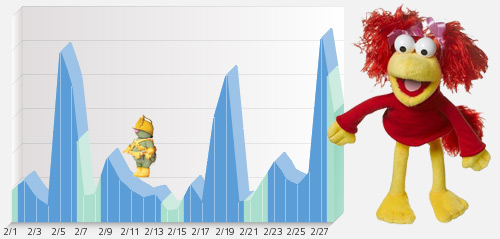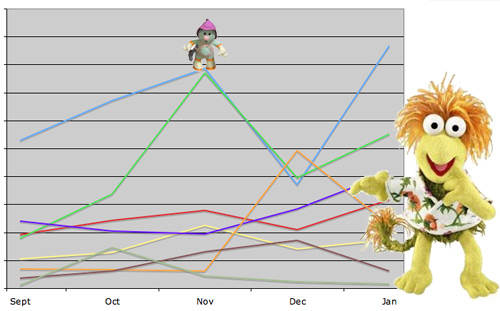I’ve been spending time looking at blog performance metrics, and wanted to share some ideas on how bloggers, editors and journalists can use web analytics to not just measure performance, but set editorial & content strategy.
Typically, people talk a lot about monthly metrics, but I find so much more value looking at daily metrics, and especially, combinations of metrics.
Once you begin segmenting the data, you really begin to understand the behavior of your visitors and their preferences.
For this little exercise, I’m mostly just going to focus on page view metrics, for a single month, on day-to-day basis. To protect the innocent, I won’t tell you whose blog metrics I am looking at or share specific data. Instead I want to dig into some basic trends that are likely applicable to your blog or your brand’s editorial content.
Because charts and graphs can be boring, I threw in some Fraggles and Doozers to make it more interesting.
- Big Spikes

This is what we all like to see, right? Something that worked. But, it can be very misleading. Two dangers here: First, a lot of bloggers and editors look at metrics on a monthly basis, so they get a single measure of page views for a given month. From one month to the next, they could see significant growth, and say to themselves – "whatever I am doing is working!" But without further research, they are really flying blind.
Sometimes you will dig deeper and see just one big spike – a SINGLE thing that they did that worked really well. Everything else was just average. That is incredibly important to uncover.
The second danger is taking that at face value. WHY did all that traffic go to that single article or blog entry? There is a reason, and there is a hard lesson: not all traffic is of the same quality. You could find any of the following scenarios:
- You chose a great topic, wrote a great piece, and it simply spread online because of the high quality of the work. The more you learn about what worked, the easier it will be to duplicate this.
- A single marketing channel paid off. Maybe it was your own newsletter, or maybe it was a link from an external website or blog.
- Or, maybe, it was a fluke, and if you dig deeper you realize that a lot of people came, but they didn’t stay for more than 10 seconds, and that 95% of them will never come back. This is particularly true for articles that happen to hit upon a broader, more popular topic, perhaps using a popular image. For instance: you write a single post about a big TV show, write about a topic that has a huge niche following (Watchmen, Star Trek, etc) or use an image of Lilly Allen in a blog entry.
There are degrees here, of course, but without digging more deeply, you can’t assume that simply because you received a lot of page views, that you fully understand the reasons why.
What is particularly interesting is to check bounce rate and time spent on this type of traffic. If people spent an average of 8 seconds on this page, and 90% of them bounced away after viewing it, then you may not have a satisfied audience, just a brief flash in the pan. In B2B media, it is all about engaging that highly specialized audience. Page views alone are just a starting point to see if this is actually happening.
-
Little Spikes

I see little spikes a lot on blogs throughout RBI, and they often match up to a simple thing: update frequency. So, when the blog is updated, it gets promoted on the homepage, in RSS feeds, in newsletters, in Google, and BOOM!, people come and visit.
The basic lesson here is: update more frequently.
But, that isn’t the only reason you could be seeing little bumps. Dig into those specific days, and think holistically about your product. If you are researching performance of articles, not blogs, consider whether these spiky articles were heavily promoted in a newsletter. Check referrer stats, see if Google suddenly fell in love with this post. Figure out whether this is something that you can easily replicate or whether it was a one-off spike.
And again, look at combinations of metrics that include engagement metrics. There are plenty of others besides bounce rate and average viewing time. It’s also enlightening to keep mixing and matching different metrics with each other. What would you understand about your readers if you only looked at traffic to your most recent articles, only during your most highly trafficked hours during lunchtime, who only came in through the homepage, and had come to your site more than once in the past month? How does this compare to readers who came in through Google? So many questions, so little time!
- Bumps

I love these bumps. It’s silly, I know, but so are all these Fraggles and Doozers. So, these bumps are for a highly evolved blog(er) – one that gets updated almost daily – who pushes out high quality posts constantly – who looks at their metrics each month for motivation – and who is always trying new and innovative things to more deeply engage their readers.
You still see small dips and spikes within each week, but you can tell that this blogger has firmly engaged a sizeable core audience each day. They even saw an opportunity on the weekends, and began posting then as well (the green sections are weekends.) It is a smaller level of traffic, but this incremental traffic builds up. They produce an entirely different kind of post on weekends – seeing it as an opportunity to engage another side of their readership.
- CHAOS!

Now, you can think about these same concepts in a number of different ways. Let’s just say you are trying to assess the overall blog strategy for your brand, and you map out the page view performance over the course of a few months. You might come up with a chart like the one above.Do you see any trends here? It’s really hard to. It is obvious that some blogs have the potential to engage a larger audience than others, but they have not found a strategy that is consistent. For the most part, these blogs are all over the place, and without digging deeper into smaller time frames and different metrics, you will be left in the dark, making broad generalizations.
So you are posed with quite a few questions here, some of which may be:
- How do I figure out what is really working?
- Where should we put more effort, and where do we put less effort?
- Do we cut some of these, or are they diamonds in the rough?
- Will that little Doozer survive if he falls?!
Here is a way you might want to approach it:
- Look at one blog at a time – choose the top one.
- Look only at blog entries in a specific period of time – say a single month, or a single week.
- Figure out where your traffic is coming from – a simple referrer report will put you in the right direction.
- For kicks, filter out all the referrer traffic from search engines to look at who your core audience is, and how they behave within your blog.
- Now start combining metrics – compare page views on a day-to-day basis within a month, but look at bounce rate and time spent. Which days were people more engaged? When did you receive traffic, and when didn’t you? Look at repeat visitors. Check to see what keywords people typed into Google that brought them to this blog.
Suddenly, by eliminating some things, and comparing other metrics in combination, you begin to get a picture of what your core is. There are so many directions you can take this – but the goal is not to just determine "what happened," but figure out changes you can make to improve performance and set strategy. When doing so, consider the following:
- Make Choices
Figure out what is worth your effort, and what is a nice idea, but not a great idea. Focus your efforts in a couple of places that will give you a big payoff and truly engage your readers.Getting rid of smaller blogs helps to not just focus your efforts, but to focus the attention of your readers. If they are confronted with 12 blogs of varying topics and quality, it adds complexity to their day. But if you show them only the best of the best – something that will truly help them, then you are in a strong position to grow your relationship.
- Create Goals
Set some expectations for yourself. How many page views could you reasonably expect to receive in a given month. Use your other content and blogs as benchmarks. If your top article in a given month receives 10,000 page views and your biggest blog received a total of 15,000 page views, then you have a starting point.You don’t have to share these goals, just ensure that you are measuring performance and beginning to understand what measures indicate growth.
If you are looking at year-over-year growth, you should be shooting for double-digit percentages at the very least.
- Build Consistency
You, your staff, and your audience need more of what works, and less of what doesn’t. Building consistency into a blog or an editorial strategy helps to focus everyone on the only goals that matter. It’s too easy to get off track, to get overwhelmed, to try to do too much.When setting a new strategy for something like a blog, create a firm schedule as to when you will update, what kind of posts you will do, and how you will market it.
I hope some of this is helpful. It is far from a complete primer on the topic – we could likely chat every day for weeks about web metrics, and still just scratch the surface. But they would not be wasted conversations. Speaking of waste, I will end today’s post with one more character from Fraggle Rock: Marjory the Trash Heap. A great description I found of her:
“Marjory the Trash Heap is a large, matronly, sentient compost heap from Fraggle Rock. According to her rat-like companions Philo and Gunge, who serve as her shills, the Trash Heap knows all and sees all. In fact Marjory is all: “I’m orange peel, I’m coffee grounds, I’m wisdom!” She serves as an oracle to the Fraggles, dispensing advice and wise sayings, and the Fraggles stand in awe and reverence of her.”

